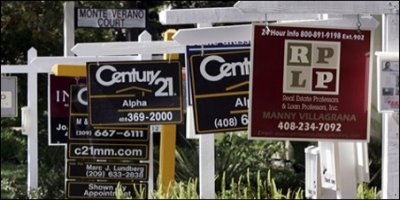January 4 2011 (Chris Moore)

When foreclosures and Real Estate Owned (REO) properties enter the housing market, they transition from what is known as the shadow inventory into the visible inventory. Shadow inventory is usually defined as homes that are seriously delinquent (90 days or more), in foreclosure and real estate owned by lenders and that are not currently listed on multiple listing services (MLSs). Shadow inventory is typically not included in the official metrics of unsold inventory. CoreLogic estimated in November, that as of August 2010 there were approximately 2.1 million properties in the shadow inventory.
Whereas visible inventory measures the unsold inventory of new and existing homes that is currently on the market. In that same report, Corelogic estimated that the total visible inventory to be approximately 4.2 million properties.
The total visible and shadow inventory was 6.3 million units in August, up from 6.1 million a year ago. The total months’ supply of unsold homes was 23 months in August, up from 17 months a year ago. Although it can vary and it depends on the market and real estate cycle, typically a reading of six to seven months is considered normal so the current total months’ supply is roughly three times the normal rate.
As staggering as those numbers may seem, they don’t tell the whole story. It’s not simply about the raw data of the homes entering the market; it’s about the quality of the homes. Specifically, homes that are of a lower quality than standard or normal homes that is for sale.
So what do we mean by lower quality? Let me explain.
Have you ever purchased a car that was a repossession, took it down to your mechanic and found out the oil hadn’t been changed in 25,000 miles? It’s a proven fact; people who know they are going to lose their car are less inclined to take care of it. Homeowners who are going to lose their homes are the same way.
And they have plenty of time to neglect their homes too. Because of the huge amount of homes in foreclosure, on average, the foreclosure process now takes about 438 days and in some states it takes longer. There have even been reports that some people have been able to stay in their homes for over two years.
As one CoreLogic report suggests, “they are less likely to maintain and improve their property and are more likely to behave like renters.”
Many of the homes that reach auction today are stripped of their contents, anything from windows, to bathrooms to whole kitchens or are just suffering from neglect. I’ve even seen it on Craigslist myself, homeowners selling the contents of their kitchens, bathrooms, and outdoor hardscaping just before losing their homes.
While banks do invest some money into the REOs that get marketed and sold, often these properties have major issues that require immediate cash investments by the buyer. But how can someone expect a first time homebuyer who is struggling to get their 3.5 percent down payment, plus closing costs, to spend 10, 20 or 30 thousand dollars on making a home livable?
Inevitably, these homes end up the hands of investors at discounted prices who fix the homes up and sell them to traditional home buyers.
And we may already be seeing the effects of the havoc being caused by these lower quality homes. If you look at the graph below, you can see an interesting trend… the number of weekly new listings over the past 16 months shows that every week, more homes are consistently entering the market in the bottom quartile, defined as the least expensive 25% of homes (black line):

In fact, if you look at the last few months we see the number of homes in the least expensive quartile increasing while the other price segments are all trending downwards. What that means is a greater percentage of lower priced homes are coming on the market compared to the other price segments.
And the price implication of these homes can be seen on the graph below:

As the increasing amount of lower priced homes comes to market, the overall price of homes on the market continues to decline, pulling down the prices of the homes of existing sellers.
What’s going on in the housing market today isn’t the result of just lower quality homes. Prices are also moving lower because of the generally weak market environment, high unemployment, a weak economy, low demand, and rising mortgage rates.
And if home prices continue to decline, it can only make things worse. Corelogic reported that in the third quarter of 2010, almost 23 percent of all residential property owners were underwater; their homes being worth less than what they owe. They also reported than an additional five percent of property owners were considered to be “near-negative” because they had less than five percent equity in their homes. The total negative equity and near-negative equity properties is now over 13 million.
And with “strategic defaults,” homeowners who are not in a distressed financial situation but walk away from their homes because they are too far underwater, becoming more acceptable and prevalent, it just adds more fodder to the cycle. Some analysts are predicting that a record 1.8 million homes will be foreclosed on this year.
If the foreclosure crisis can be compared to a tsunami, then despite what you may believe, the number of homes transitioned from the shadow inventory to the visible inventory would seem more like a trickle. And if you think that by restraining the amount of foreclosures in the market will help housing prices, think again; housing prices since the infamous “robo-signing” incident have continued to decline since then. But it’s easy to see why, because even though the amount of foreclosed properties for sale has been greatly reduced, go back and look at the top chart and you can once again see that most of the homes entering the market are in the least expensive quartile.
So what’s happening to all of these other properties? The banks are still holding on to them. Maybe they’re waiting for the market to come back so they can sell them at a higher price? Only the banks know for sure, but if they decide to slowly release homes from their shadow inventories, especially the lower quality homes, we can expect to see several years of relatively flat and low prices.
Tags: defaults, foreclosures, distressed property, shadow inventory, visible inventory, housing, housing recovery, mortgage lenders, foreclosed properties




